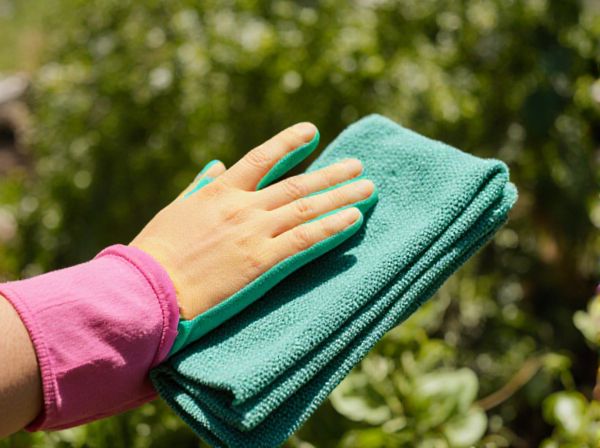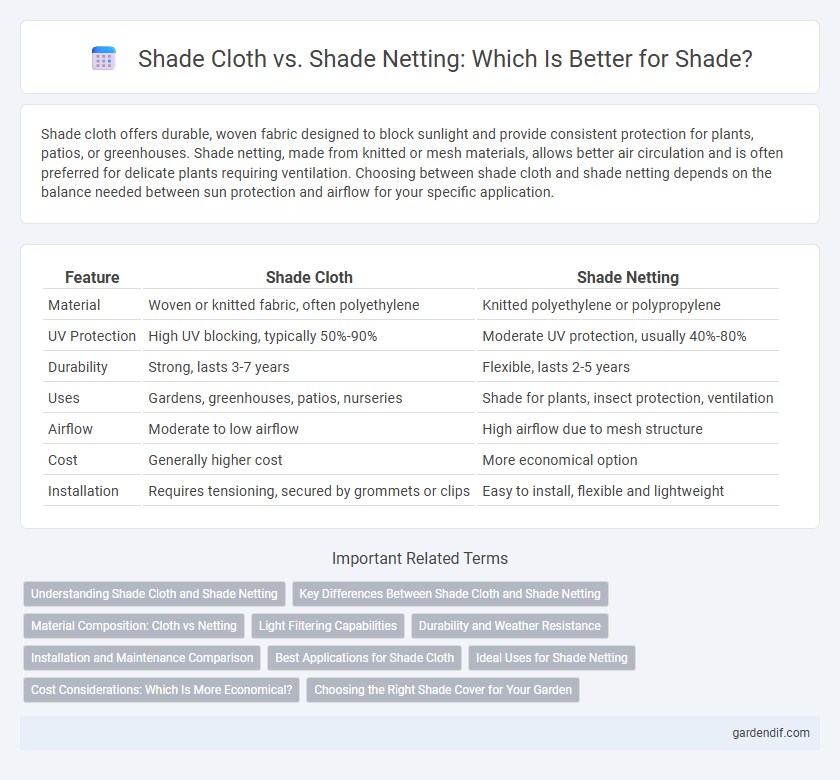
Shade Cloth vs Shade Netting Illustration
Shade cloth offers durable, woven fabric designed to block sunlight and provide consistent protection for plants, patios, or greenhouses. Shade netting, made from knitted or mesh materials, allows better air circulation and is often preferred for delicate plants requiring ventilation. Choosing between shade cloth and shade netting depends on the balance needed between sun protection and airflow for your specific application.
Table of Comparison
| Feature | Shade Cloth | Shade Netting |
|---|---|---|
| Material | Woven or knitted fabric, often polyethylene | Knitted polyethylene or polypropylene |
| UV Protection | High UV blocking, typically 50%-90% | Moderate UV protection, usually 40%-80% |
| Durability | Strong, lasts 3-7 years | Flexible, lasts 2-5 years |
| Uses | Gardens, greenhouses, patios, nurseries | Shade for plants, insect protection, ventilation |
| Airflow | Moderate to low airflow | High airflow due to mesh structure |
| Cost | Generally higher cost | More economical option |
| Installation | Requires tensioning, secured by grommets or clips | Easy to install, flexible and lightweight |
Understanding Shade Cloth and Shade Netting
Shade cloth and shade netting are essential materials used in agriculture and horticulture to protect plants from excessive sunlight and heat. Shade cloth is typically made from knitted or woven fabric that provides consistent shading and UV protection, while shade netting consists of more open mesh structures that allow greater airflow and are often used for pest control alongside shading. Understanding the differences in material composition, shading percentage, and application techniques helps optimize plant growth and environmental control.
Key Differences Between Shade Cloth and Shade Netting
Shade cloth is typically made from woven polypropylene or polyethylene, providing UV protection and reducing sunlight by varying densities, ideal for agricultural and horticultural uses. Shade netting, often crafted from knitted polyethylene, offers greater durability and flexibility, featuring a mesh design that allows better airflow while still providing shade. The key differences lie in material composition, structure, and intended application, with shade cloth prioritizing sun blockage and shade netting balancing shade and ventilation.
Material Composition: Cloth vs Netting
Shade cloth is typically made from woven or knitted polyethylene fibers, creating a solid fabric that blocks sunlight while allowing air circulation. Shade netting comprises loosely woven or knitted synthetic threads, forming an open mesh structure that reduces sunlight penetration without fully obstructing airflow. The choice between shade cloth and netting depends on the desired balance between light diffusion and ventilation for specific agricultural or horticultural applications.
Light Filtering Capabilities
Shade cloth offers precise light filtering, allowing for controlled sunlight reduction typically ranging from 30% to 90%, which enhances plant growth by protecting against excessive heat. Shade netting provides a looser weave that permits more airflow and partial light penetration, suitable for applications requiring moderate sun protection and ventilation. Both materials serve different horticultural needs based on their light diffusion and UV filtering properties.
Durability and Weather Resistance
Shade cloth, typically made from woven polyethylene, offers superior durability and resilience against harsh weather conditions, including strong winds and UV radiation. Shade netting, constructed from knitted polyester or nylon, provides flexibility but tends to have less longevity and may degrade faster under prolonged exposure to sun and rain. For long-term outdoor use, shade cloth's robust material and tighter weave ensure enhanced protection and resistance to environmental wear.
Installation and Maintenance Comparison
Shade cloth typically requires installation using grommets and rope or zip ties, making it easy to stretch and secure over frames or structures, while shade netting often involves tying or clipping onto a framework, which may be more labor-intensive. Maintenance of shade cloth involves periodic cleaning to remove dirt and debris and checking for tears that can be easily patched; shade netting, being finer and more delicate, demands careful handling to prevent snagging and may require more frequent inspections. Both materials benefit from seasonal removal or storage to prolong lifespan, but shade cloth generally offers more straightforward installation and maintenance due to its sturdier fabric.
Best Applications for Shade Cloth
Shade cloth is ideal for agricultural applications requiring precise light filtration, such as protecting crops from excessive sunlight while maintaining airflow for plant health. Its tightly woven fabric ensures durable UV protection and temperature control, making it suitable for greenhouses, nurseries, and garden areas. Shade cloth also excels in commercial and residential settings where long-term sun protection and wind resistance are needed.
Ideal Uses for Shade Netting
Shade netting excels in agricultural and horticultural applications, providing precise control over sunlight intensity to protect crops, plants, and seedlings from excessive heat and UV radiation. Its breathable structure ensures optimal air circulation, reducing humidity and preventing fungal diseases while maintaining a stable microclimate. Ideal for greenhouses, nurseries, and outdoor plant nurseries, shade netting improves plant growth and yield by creating favorable growing conditions.
Cost Considerations: Which Is More Economical?
Shade cloth typically offers a more economical option than shade netting due to its durable woven fabric, which provides long-term value with minimal replacement needs. Shade netting, often made from knitted or extruded materials, may have lower upfront costs but can require more frequent maintenance or replacement, increasing overall expenses. Evaluating total cost of ownership, including installation, durability, and lifespan, reveals shade cloth as the cost-effective choice for sustained shade solutions.
Choosing the Right Shade Cover for Your Garden
Shade cloth offers durable UV protection with varying densities ideal for controlling sunlight and temperature in gardens, while shade netting provides lightweight ventilation and flexibility for delicate plants that require airflow. Choosing the right shade cover depends on the specific needs of your garden, such as plant type, climate, and desired sunlight reduction, typically measured in percentage blocks from 30% to 90%. Proper selection enhances plant growth, conserves water, and reduces heat stress, making it essential to evaluate both materials' durability, UV resistance, and airflow properties.
Shade Cloth vs Shade Netting Infographic

 gardendif.com
gardendif.com